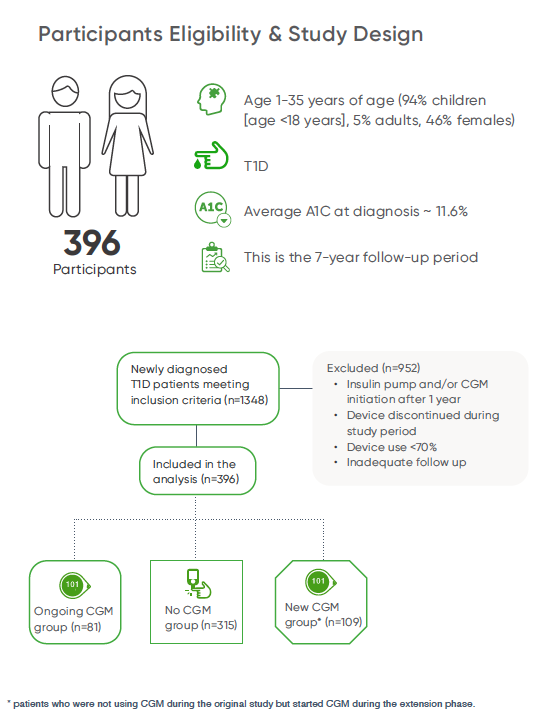Request a representative visit or G7 samples
CGM initiation within 1st year of diagnosis proven to reduce A1C
Continuous Glucose Monitoring Initiation Within First Year of Type 1 Diabetes Diagnosis Is Associated With Improved Glycemic Outcomes: 7-Year Follow-Up Study
Anagha Champakanath, Halis Kaan Akturk, G. Todd Alonso, Janet K. Snell-Bergeon, and Viral N. Shah Diabetes Care. 2022 Mar 1;45(3):750-753. doi: 10.2337/dc21-2004.
This is an extension of a previously published study. Electronic medical records of patients with type 1 diabetes (T1D) were evaluated, between 1 and 35 years of age, diagnosed between January 2013 and December 2015. For the extension study, data were collected at each visit from the onset of T1D through a 7-year follow-up period.1
Objective
The purpose of this study was to evaluate improving A1C levels and the long-term glycemic outcomes of CGM initiation within the first year of type 1 diabetes diagnosis.
Study Outcomes Measured
The primary outcome of the study was the change in A1C over time between the CGM and non-CGM groups, monitoring improving A1C levels in patients
The secondary outcome was the difference in A1C between the new CGM group* and non-CGM group

Results
A total of 396 people with T1D (n=372 children aged < 18 years; n=24 adults aged ≥ 18 years) were included in the analysis and followed up to 7 years. A1C was significantly lower in the ongoing CGM group compared to the no-CGM group throughout the 7-year follow up period, adjusting for age at diagnosis, sex, and insulin delivery method followed for 7 years.1

Key TAKEAWAYS
CGM initiation within the first year of T1D diagnosis resulted in long-term improvements in A1C1
First study1 to demonstrate improvement in A1C over 7 years with CGM initiation within first year of diabetes diagnosis in patients with T1D. However, improvements in A1C were seen with use of CGM regardless of when it was initiated.
Sustained improvement in A1C was significantly better in those who initiated CGM within the first year of diabetes diagnosis compared with CGM initiation after 2.5 years of T1D. While the general target A1C average for adults with diabetes is below 7%, individual goals vary based on factors like patient age, health conditions, and risk of hypoglycemia.
1. Anagha Champakanath, Halis Kaan Akturk, G. Todd Alonso, Janet K. Snell-Bergeon, Viral N. Shah; Continuous Glucose Monitoring Initiation Within First Year of Type 1 Diabetes Diagnosis Is Associated With Improved Glycemic Outcomes: 7-Year Follow-Up Study; Diabetes Care 2022 Mar 1;45(3):750-753. doi: 10.2337/dc21-2004.
LBL-1002664 Rev001
Related Content
Topics: Pregnancy, Accuracy, Safety Research Spotlight: “Accuracy and Safety of Dexcom G7 CGM Use in Pregnancy Patients with Diabetes” Polsky S, et al. Diabetes Technol Ther. 2024;26(5):307-12...
Title: Long-Term Improvements in Glycemic Control with Dexcom CGM Use in Adults with Noninsulin-Treated Type 2 Diabetes Topics: Long-Term Outcomes, Type 2 Diabetes, Noninsulin-Treated Research...

